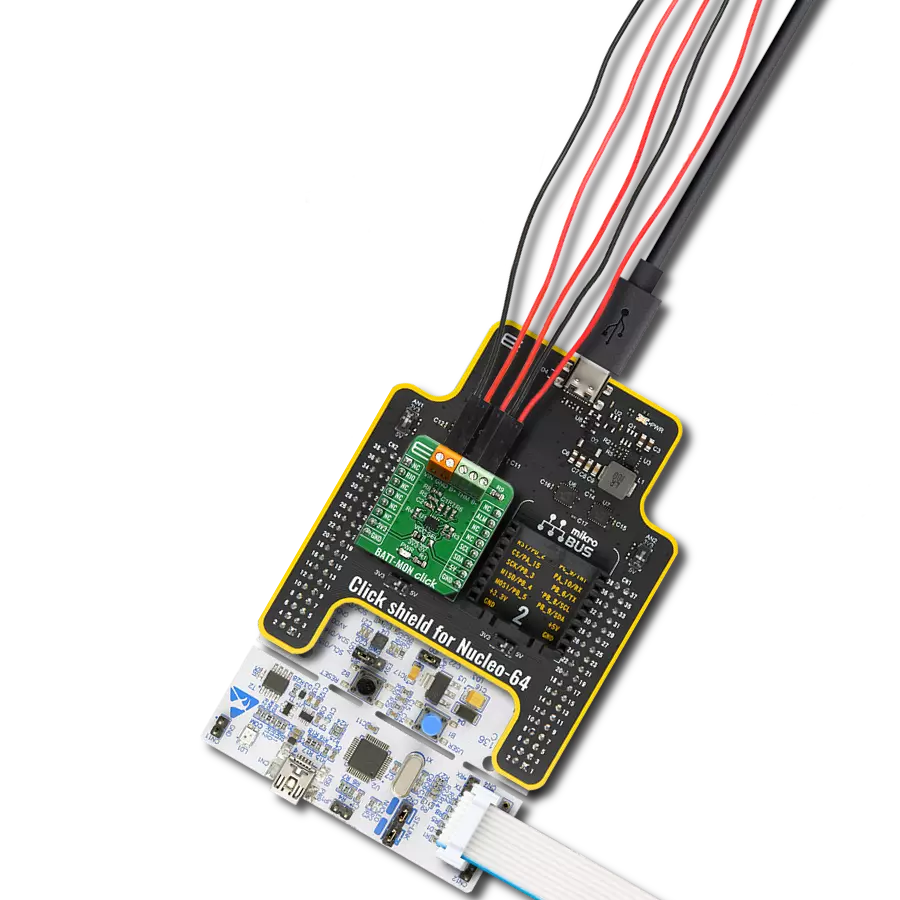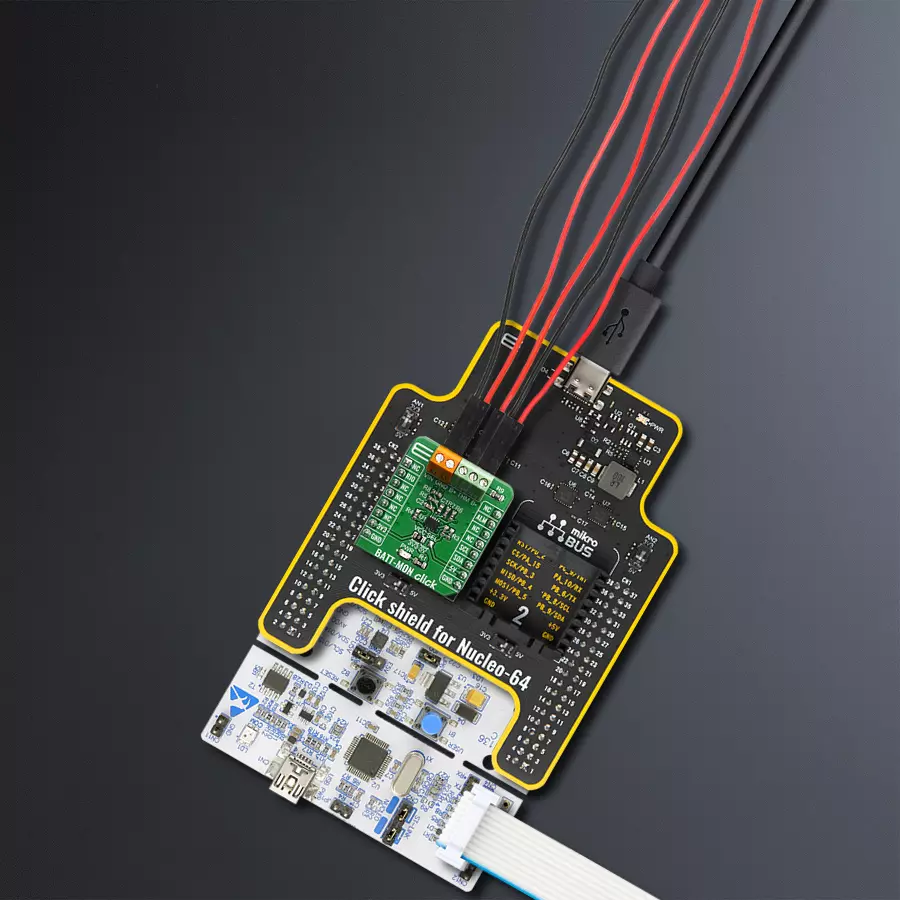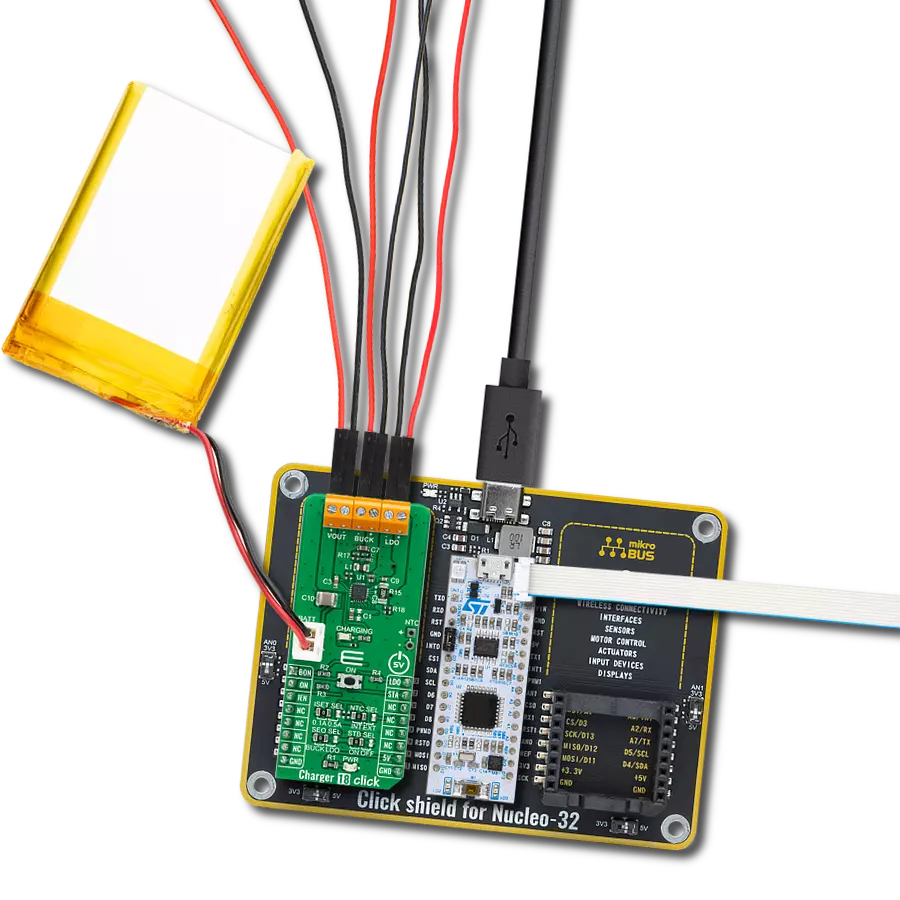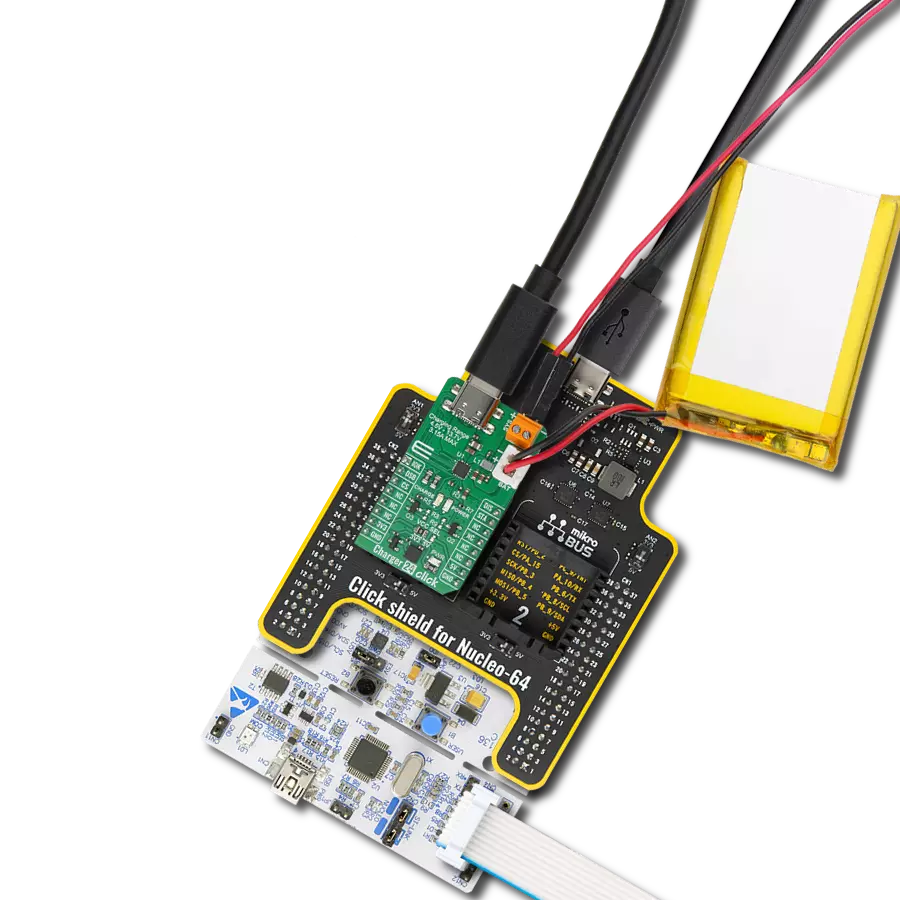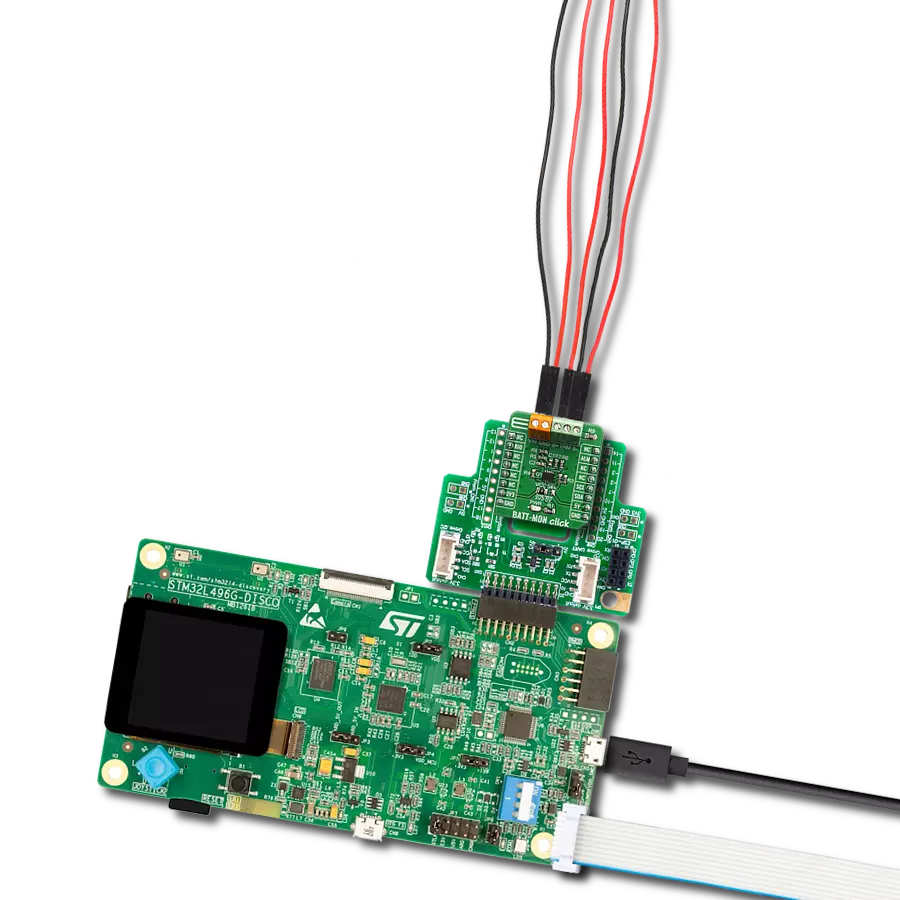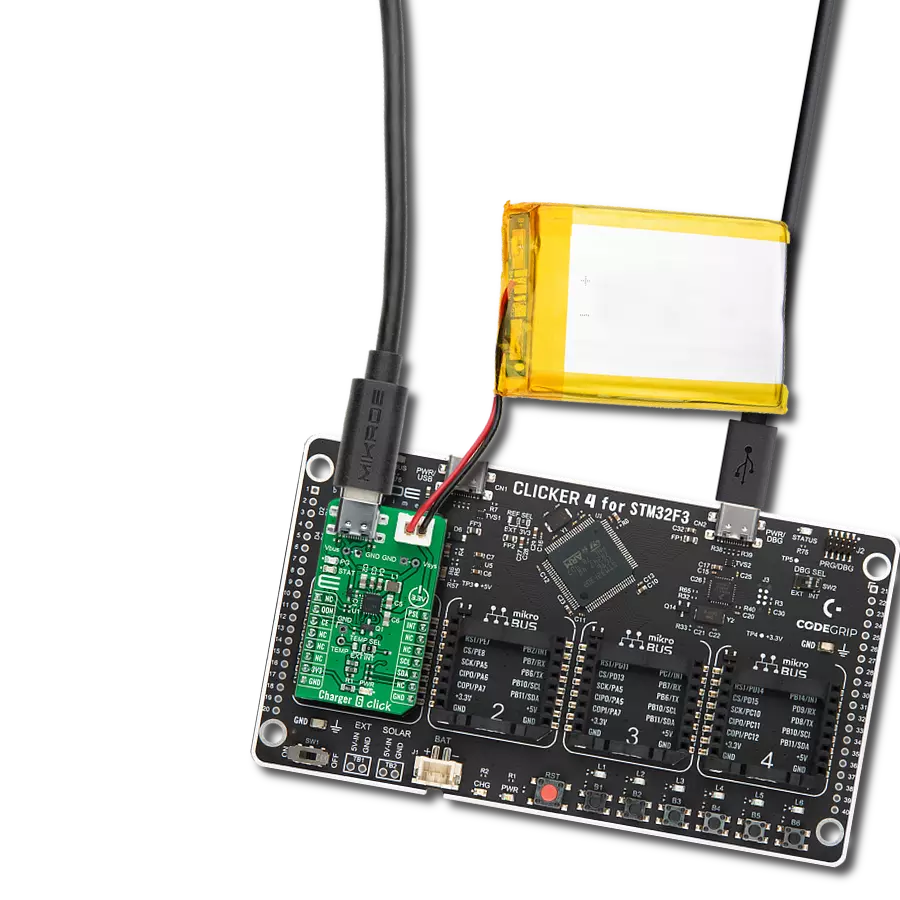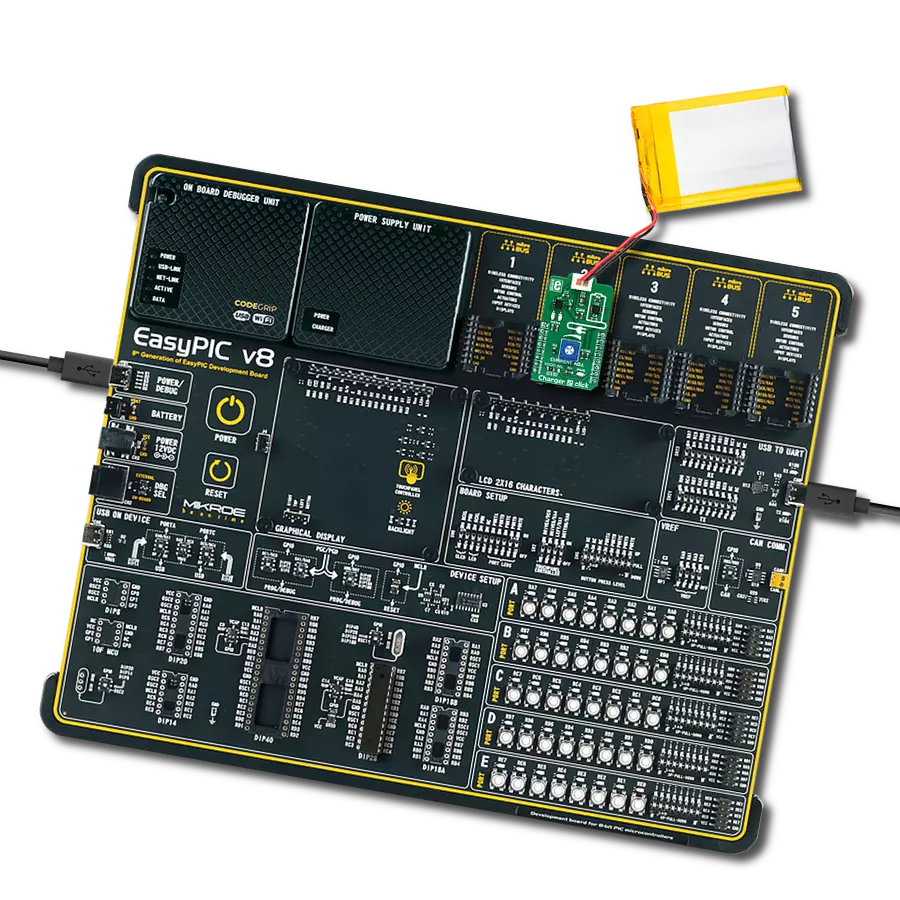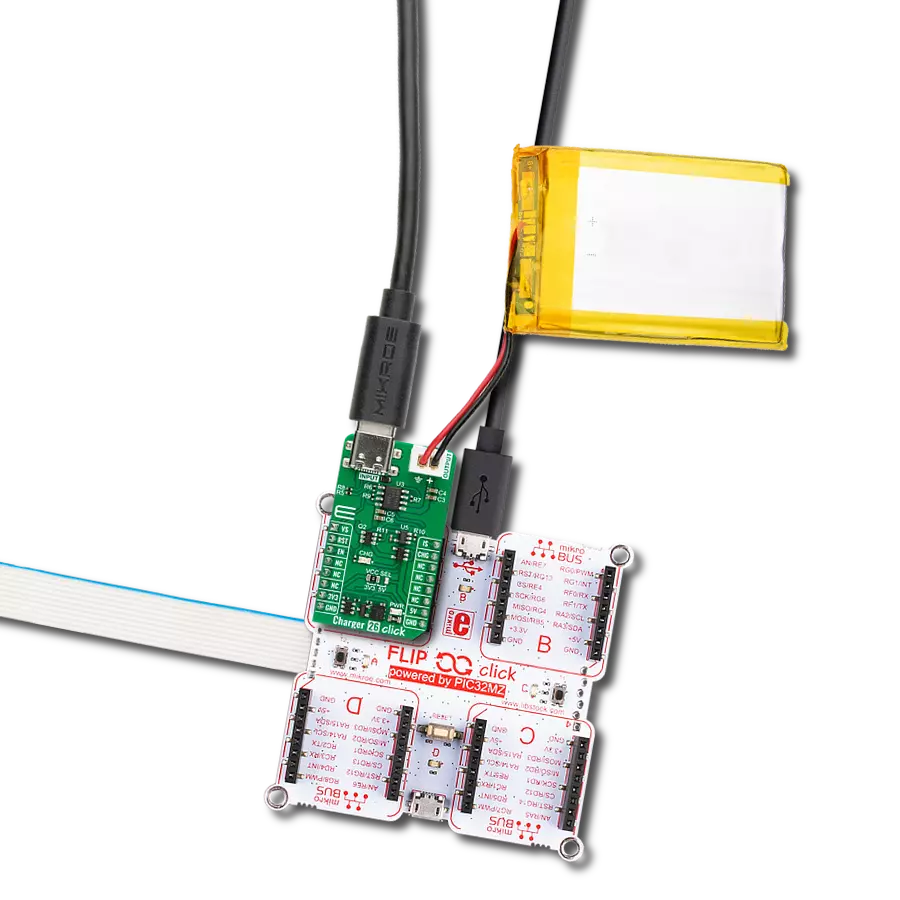A battery monitoring solution that provides valuable insights into your battery's performance, helping you identify issues and optimize its usage
A
A
Hardware Overview
How does it work?
BATT-MON Click is based on the STC3115, a high-precision battery gas gauge IC with alarm output for handheld applications, from STMicroelectronics. It includes all necessary components for the STC3115 to ensure the proper functionality of the Click board™ and maintain the monitoring precision. The monitoring functions include the measurement of battery voltage, current, and temperature. A Coulomb counter is available to track the SOC when the battery is charging or discharging at a high rate. A sigma-delta A/D converter measures the voltage, current, and temperature. The STC3115 can operate in two different modes with different power consumption. Mode selection is made by the VMODE bit in register 0. For more information about registers and operating
modes, refer to the modes STC3115 datasheet. Battery voltage is measured by using one conversion cycle of the A/D converter every 4 s. The conversion cycle takes 8192 clock cycles, which means that when the internal 32768Hz clock is used, the conversion cycle time is 250ms. The voltage range is 0 to 4.5V, and the resolution is 2.20mV. The accuracy of the voltage measurement is ±0.5% over the temperature range. This allows accurate SOC information from the battery open-circuit voltage. The voltage drop across the sense resistor (R9) for current sensing is measured with the internal 14-bit sigma-delta A/D converter. Using the 32768Hz internal clock, the conversion cycle time is 500 ms for a 14-bit resolution. The LSB value is 5.88μV. The A/D converter output is in two’s complement format.
When a conversion cycle is completed, the result is added to the Coulomb counter accumulator, and the number of conversions is incremented in a 16-bit counter. The current register is updated only after the conversion closest to the voltage conversion (once per 4s measurement cycle). The result is stored in the REG_CURRENT register. This Click board™ can operate with either 3.3V or 5V logic voltage levels selected via the VCC SEL jumper. This way, both 3.3V and 5V capable MCUs can use the communication lines properly. However, the Click board™ comes equipped with a library containing easy-to-use functions and an example code that can be used, as a reference, for further development.
Features overview
Development board
Nucleo-64 with STM32F091RC MCU offers a cost-effective and adaptable platform for developers to explore new ideas and prototype their designs. This board harnesses the versatility of the STM32 microcontroller, enabling users to select the optimal balance of performance and power consumption for their projects. It accommodates the STM32 microcontroller in the LQFP64 package and includes essential components such as a user LED, which doubles as an ARDUINO® signal, alongside user and reset push-buttons, and a 32.768kHz crystal oscillator for precise timing operations. Designed with expansion and flexibility in mind, the Nucleo-64 board features an ARDUINO® Uno V3 expansion connector and ST morpho extension pin
headers, granting complete access to the STM32's I/Os for comprehensive project integration. Power supply options are adaptable, supporting ST-LINK USB VBUS or external power sources, ensuring adaptability in various development environments. The board also has an on-board ST-LINK debugger/programmer with USB re-enumeration capability, simplifying the programming and debugging process. Moreover, the board is designed to simplify advanced development with its external SMPS for efficient Vcore logic supply, support for USB Device full speed or USB SNK/UFP full speed, and built-in cryptographic features, enhancing both the power efficiency and security of projects. Additional connectivity is
provided through dedicated connectors for external SMPS experimentation, a USB connector for the ST-LINK, and a MIPI® debug connector, expanding the possibilities for hardware interfacing and experimentation. Developers will find extensive support through comprehensive free software libraries and examples, courtesy of the STM32Cube MCU Package. This, combined with compatibility with a wide array of Integrated Development Environments (IDEs), including IAR Embedded Workbench®, MDK-ARM, and STM32CubeIDE, ensures a smooth and efficient development experience, allowing users to fully leverage the capabilities of the Nucleo-64 board in their projects.
Microcontroller Overview
MCU Card / MCU

Architecture
ARM Cortex-M0
MCU Memory (KB)
256
Silicon Vendor
STMicroelectronics
Pin count
64
RAM (Bytes)
32768
You complete me!
Accessories
Click Shield for Nucleo-64 comes equipped with two proprietary mikroBUS™ sockets, allowing all the Click board™ devices to be interfaced with the STM32 Nucleo-64 board with no effort. This way, Mikroe allows its users to add any functionality from our ever-growing range of Click boards™, such as WiFi, GSM, GPS, Bluetooth, ZigBee, environmental sensors, LEDs, speech recognition, motor control, movement sensors, and many more. More than 1537 Click boards™, which can be stacked and integrated, are at your disposal. The STM32 Nucleo-64 boards are based on the microcontrollers in 64-pin packages, a 32-bit MCU with an ARM Cortex M4 processor operating at 84MHz, 512Kb Flash, and 96KB SRAM, divided into two regions where the top section represents the ST-Link/V2 debugger and programmer while the bottom section of the board is an actual development board. These boards are controlled and powered conveniently through a USB connection to program and efficiently debug the Nucleo-64 board out of the box, with an additional USB cable connected to the USB mini port on the board. Most of the STM32 microcontroller pins are brought to the IO pins on the left and right edge of the board, which are then connected to two existing mikroBUS™ sockets. This Click Shield also has several switches that perform functions such as selecting the logic levels of analog signals on mikroBUS™ sockets and selecting logic voltage levels of the mikroBUS™ sockets themselves. Besides, the user is offered the possibility of using any Click board™ with the help of existing bidirectional level-shifting voltage translators, regardless of whether the Click board™ operates at a 3.3V or 5V logic voltage level. Once you connect the STM32 Nucleo-64 board with our Click Shield for Nucleo-64, you can access hundreds of Click boards™, working with 3.3V or 5V logic voltage levels.
Used MCU Pins
mikroBUS™ mapper
Take a closer look
Click board™ Schematic
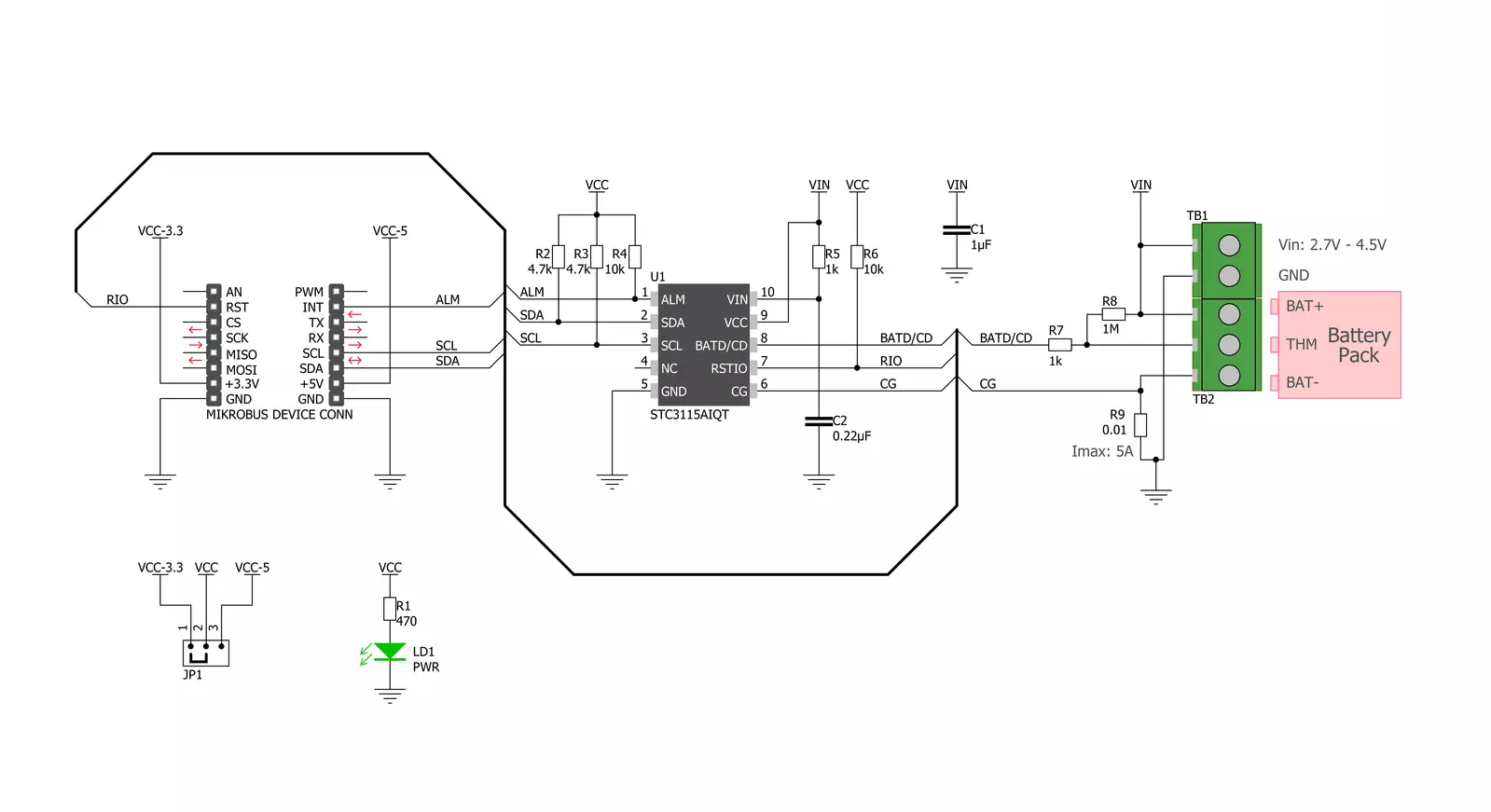
Step by step
Project assembly
Software Support
Library Description
This library contains API for BATT-MON Click driver.
Key functions:
battmon_get_data- Data Get functionbattmon_get_alm_pin- ALM Pin Get functionbattmon_reset_conv_cnt- Conversion Counter Reset function
Open Source
Code example
The complete application code and a ready-to-use project are available through the NECTO Studio Package Manager for direct installation in the NECTO Studio. The application code can also be found on the MIKROE GitHub account.
/*!
* \file
* \brief BattMon Click example
*
* # Description
* This application is battery charger.
*
* The demo application is composed of two sections :
*
* ## Application Init
* Initializes I2C serial interface, reads the part ID and
* performs a device configuration and alarm setting.
*
* ## Application Task
* Checks the conversion counter value and when conversion was done
* reads data calculated to the properly unit and checks the alarm status.
* All results will be sent to the uart terminal.
*
* *note:*
* Voltage and current conversion will be done after 4 seconds.
* Temperature conversion will be done after 16 seconds.
* After temperature reading the conversion counter will be cleared.
* Clearing the alarm while the corresponding low-voltage or low-SOC condition is still in progress
* does not generate another interrupt. This condition must disappear first and must be detected again
* before another interrupt (ALM pin driven low or alarm interrupt bits are set high) is generated for this alarm.
* Another alarm condition, if not yet triggered, can still generate an interrupt.
* Input voltage must be in the range from 2.7V to 4.5V.
* Maximal battery current is 5A.
*
* \author MikroE Team
*
*/
// ------------------------------------------------------------------- INCLUDES
#include "board.h"
#include "log.h"
#include "battmon.h"
// ------------------------------------------------------------------ VARIABLES
static battmon_t battmon;
static log_t logger;
static uint8_t reg_read;
// ------------------------------------------------------ APPLICATION FUNCTIONS
void application_init ( void )
{
log_cfg_t log_cfg;
battmon_cfg_t cfg;
/**
* Logger initialization.
* Default baud rate: 115200
* Default log level: LOG_LEVEL_DEBUG
* @note If USB_UART_RX and USB_UART_TX
* are defined as HAL_PIN_NC, you will
* need to define them manually for log to work.
* See @b LOG_MAP_USB_UART macro definition for detailed explanation.
*/
LOG_MAP_USB_UART( log_cfg );
log_init( &logger, &log_cfg );
log_info( &logger, "---- Application Init ----" );
// Click initialization.
battmon_cfg_setup( &cfg );
BATTMON_MAP_MIKROBUS( cfg, MIKROBUS_1 );
battmon_init( &battmon, &cfg );
Delay_ms ( 500 );
battmon_read_bytes( &battmon, BATTMON_REG_ID, ®_read, 1 );
log_printf( &logger, " ** Part ID: 0x%d \r\n", (uint16_t) reg_read );
battmon_default_cfg( &battmon );
log_printf( &logger, "** BattMon initialization done ** \r\n" );
log_printf( &logger, "********************************* \r\n" );
}
void application_task ( void )
{
char cels_symbol[ 3 ] = { 176, 'C', 0 };
float data_read;
uint16_t conv_cnt;
conv_cnt = battmon_get_data( &battmon, BATTMON_REG_COUNTER );
if ( ( ( conv_cnt % 4 ) == 0 ) && ( conv_cnt > 0 ) )
{
data_read = battmon_get_data( &battmon, BATTMON_REG_SOC );
log_printf( &logger, "** Gas Gauge Relative SOC : %.2f %% \r\n ", data_read );
data_read = battmon_get_data( &battmon, BATTMON_REG_CURRENT );
log_printf( &logger, "** Battery Current : %.2f mA \r\n", data_read );
data_read = battmon_get_data( &battmon, BATTMON_REG_VOLTAGE );
log_printf( &logger, "** Battery Voltage : %.2f mV \r\n", data_read );
if ( ( conv_cnt % 16 ) == 0 )
{
data_read = battmon_get_data( &battmon, BATTMON_REG_TEMPERATURE );
battmon_reset_conv_cnt( &battmon );
log_printf( &logger, "** Temperature : %.2f %s\r\n", data_read, cels_symbol );
}
reg_read = battmon_check_clear_alarm( &battmon );
if ( ( reg_read & BATTMON_ALM_SOC_DET_MASK ) != BATTMON_LOG_LOW )
{
log_printf( &logger, "** Low-SOC Condition! \r\n" );
}
if ( ( reg_read & BATTMON_ALM_VOLT_DET_MASK ) != BATTMON_LOG_LOW )
{
log_printf( &logger, "** Low-Voltage Condition! \r\n" );
}
log_printf( &logger, "********************************* \r\n" );
Delay_ms ( 1000 );
}
else
{
Delay_ms ( 200 );
}
}
int main ( void )
{
/* Do not remove this line or clock might not be set correctly. */
#ifdef PREINIT_SUPPORTED
preinit();
#endif
application_init( );
for ( ; ; )
{
application_task( );
}
return 0;
}
// ------------------------------------------------------------------------ END
Additional Support
Resources
Category:Battery charger
